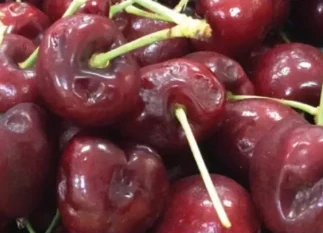Imagine being able to vaccinate your cherry trees to help them fight X-disease.
A molecular biologist recently hired at the USDA’s Wapato, Washington laboratory has launched a research program aimed precisely at this—even though the scientist himself doesn’t fully embrace my analogy with a vaccine because plant immune systems are very different from those of animals.
“It’s like a long, slow dose of antibiotics,” said Marco Pitino. Only the trees would produce their own medicine after inoculation with a genetically modified agrobacterium, which creates a small biofactory—patented and branded as Symbiont—on the trunk.
“The agrobacterium is the best molecular biologist in the world, with 1 million years of experience,” Pitino said. “It introduces a gene to produce food for itself, to build its home. Now, the ones we’ve used in the laboratory are disarmed.... We keep the genes that create the structure and introduce a gene of interest.”
The result functions like a self-sufficient insulin patch, producing a steady dose of molecules that keeps the tree regulated. This analogy is courtesy of Kevin Hackett, the national program leader for the USDA’s Agricultural Research Service.
“It’s a way to deliver different therapeuthics,” Hackett explained, who discussed the technology first tested in citrus and now being studied in many crops. “The Symbiont system promises to transform agriculture and address plant diseases (transmitted by vectors).”
It sounds like science fiction, but the Symbiont system developed by the USDA is proving promising in the citrus industry, where Pitino was part of a large research team working on the USDA’s $15 million National Institute of Food and Agriculture project: “Therapeutic Molecule Evaluation and Field Delivery Pipeline.”
As part of this project, scientists used new genetic technology to combat huanglongbing, also known as citrus greening or HLB. Field trials are underway as part of a regulatory review by the USDA Animal and Plant Health Inspection Service.
Plants vs. Pathogens
To explain his research, Pitino starts with the basics of the arms race between plants and pathogens.
“Plants are constantly bombarded by fungi and bacteria, but they don’t get sick,” he said. What makes specific pathogens, like the X-disease phytoplasma or the HLB bacterium, successful enemies is that they have developed a chemical warfare to suppress their hosts' immune response.
When plant cells recognize an invader, they usually release reactive oxygen, which burns a small hole in the plant tissue to prevent the pathogen from spreading, Pitino said. The pathogens have developed “effectors” that inhibit this response, turning the host into a nice home for themselves.
To illustrate how powerful the effectors are, Pitino and his colleagues in Florida attempted an experiment to transfer an effector gene from the bacterium causing HLB into a small “lab rat” plant commonly used in laboratory experiments. Trained dogs that can recognize HLB-infected trees were able to identify plants expressing the effector gene, even though they were not infected with the pathogen itself.
By studying the DNA of the X-disease phytoplasma, which has 466 genes, Pitino hopes to identify the effectors that give it its pathogenic power. So far, he is sifting through more than a dozen candidates using gene editing to express them in these lab plants and then observing what they do.
Small Injections into the Trunk
Determining what a future Symbiont should produce to help combat X-disease requires a lot of trial and error. To conduct these tests in a greenhouse, Pitino has created a delivery system using a 3D-printed tube and a seal made with a sticky silicone sold as fishing bait.
The method is inspired by the trunk injection approach that some Florida growers use to administer antibiotics, but it is scaled down for small greenhouse trees.
During a visit by Good Fruit Grower in June, Pitino and lab technician Douglas Harper tested the system on a cherry tree using blue food dye. Twenty minutes later, the blue dye was evident in the veins of the flowers and young leaves, demonstrating that the dye was being transported, as desired, through the xylem.
Tests on Cherries
This spring, several Northwest nurseries donated over 2,000 cherry trees to Pitino’s new lab. “Now that we have the plants, we can really see how cherries perform with the Symbionts,” Pitino said.
A new grant from the Washington Tree Fruit Research Commission also supports the work on cherries; the latest federal budget request for the USDA also seeks additional funds to study Symbiont technology at the Wapato laboratory, Cooper said.
To create a Symbiont, Pitino makes a small wound in the tree’s bark and inoculates it with a solution containing the engineered agrobacterium. He then covers it to protect it from light during its development.
Around the laboratory, you can see potted cherry trees supporting engineered Symbionts to produce green fluorescent proteins that Pitino and Harper can track through the plant using black lights. The structure of the biofactory integrates into the plant’s vascular system, allowing molecules to flow, but without any exchange of DNA.
The DNA of the cultivated plant is not altered. This, Pitino and his colleagues hope, will help the Symbiont approach gain regulatory and ultimately industrial approval.
Read the full article: Good Fruit Grower
Image: Good Fruit Grower
Cherry Times - All rights reserved












